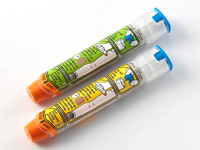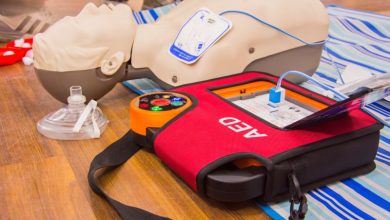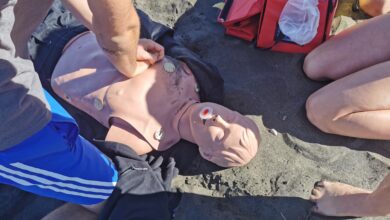A shot of adrenaline

 When Noah Smith starts school in November his teachers will need to know what to do if he has an allergic reaction.
When Noah Smith starts school in November his teachers will need to know what to do if he has an allergic reaction.
Four year old Noah is highly allergic to tree nuts, including cashew, macadamia and pistachio nuts, and carries a shot of adrenaline as a precaution against anaphylactic shock.
Kate Smith, Noah’s mother, says his allergies first became apparent when he visited a friend’s house and broke out in hives. “We didn’t realise what it was initially then a few months later we were eating cashew nuts and the hives came on instantly and he started coughing. We took him to A& E and found that his airways had started to swell,” she says.
To prevent this happening in the future, and to deal with any immediate reactions Noah has when out and about, Smith has put together a special kit for Noah to take to kindergarten and, eventually, to school. The kit contains the anti-histamine Phenergan, a trainer Epi-Pen and the Epi-Pen that contains the shot of adrenalin. The kit also has Noah’s anaphylaxis plan taped to the top so his teachers know exactly which steps to take in an emergency.
When Noah first started kindergarten, Smith says she talked through the steps with his teachers. “I ran through how to use the Epi-Pen, the symptoms he was likely to have, and how best to manage them,” she says. “When he starts school later this year I will also talk to his teachers and the school support staff.”
Severe allergies to common foodstuffs, such as eggs, nuts, dairy, fish and wheat, appear to be more common than ever before and it is believed that between five and eight per cent of all children under five will have some sort of food allergy. Many will grow out of it before they start school but there is a small number who will suffer from severe allergic reactions for the rest of their lives.
However, it is not just food that can cause a severe reaction. Contact with insect stings and bites, latex and other medications can also have extreme consequences for those with allergies.
For children like Noah, carrying adrenaline and avoiding certain foods and other allergens is just a part of life, but for many teachers and school office staff it can be difficult to know what to do and how to react if a student goes into anaphylactic shock.
Best practice guidelines developed by the Australasian Society of Clinical Immunology and Allergy (ASCIA) for those having an anaphylactic reaction follow five steps – the student should be lain flat, the Epi-Pen or Ana-Pen administered, call for an ambulance (and state it is for anaphylactic shock and adrenaline is needed as some ambulances don’t carry adrenaline), then call the student’s parents and finally administer another dose of adrenalin after five minutes if there has been no response.
Each of these steps should be detailed on an allergy or anaphylaxis plan, signed by the student’s doctor, and supplied to the school by the student’s parents. This should then be displayed in a commonly used area of the school so it can be referred to quickly in case of an emergency. Schools should also plan the management of the student’s allergies when on school camps and trips outside the classroom.
Despite the potentially serious consequences of food and other allergies, experts believe schools should not implement blanket bans on certain foods, nor should they separate students with food allergies from other students at meal times. Instead it is recommended that general policies such as no sharing of food and washing your hands after eating are implemented.
Smith agrees with these recommendations. “It is ok to have nuts at school, they are a nutritious and healthy snack for many children,” she says. “For children with allergies, like Noah, it teaches them to ask what is in prepared food and they just need to be aware that they can’t eat other children’s food.”
It also teaches children without allergies about consideration for others and responsibility, she says. “My nephew has more serious allergies than Noah and one of his friends told his mother he didn’t want peanut butter sandwiches one day because he wanted to sit with my nephew at lunchtime. These children are five years old and are already showing compassion and taking responsibility for their friends.”
More information on allergies and how schools can develop plans and policies to deal with them can be gained from Allergy New Zealand, a national charity that has developed a set of guidelines for schools that is approved by the Ministry of Education. See www.allergy.org.nz for further details.
By Rebecca Wood









